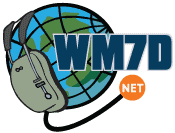
|
K7RA's Solar ReportHit refresh if this report appears out of date. It is updated every friday morning.Last update: Friday, 17-Jan-2025 03:31:38 UTC |

|
K7RA's Solar ReportHit refresh if this report appears out of date. It is updated every friday morning.Last update: Friday, 17-Jan-2025 03:31:38 UTC |
SB PROP @ ARL $ARLP003
ARLP003 Propagation DE K7RA
QST DE W1AW
ARRL Propagation Bulletin 3 Seattle, Washington
January 17, 2025Sorry to say this is the last ARRL Propagation Bulletin I will write. Took over in 1991 from W1HDQ when he was too ill and weak to continue, and now with ALS I have similar problems.
Geomagnetic influencers were more stable this week, (planetary A index shifted from 16.9 to 10.7) and solar indicators were weaker. Average daily sunspot number changed from 159.1 to 103.3 and average daily solar flux from 184.3 to 161.9.
Predicted activity indicates solar flux at 210 on January 17-18, 215 on January 19, 220 on January 20-21, 215 on January 22, 220 on January 23-24, 170 on January 25-26, 175 on January 27-28, 170 on January 29-30, then 165 and 160 on January 31, 2024 through February 1, 2025, 155 on February 2-3, 150 on February 4-6, 145 on February 7-8, 150 on February 9, 145 on February 15, 15, 12y 10-12, 150 on February 13, 155 on February 14-15, 160 on February 16, and 165 on February 17-20.
The forecast for planetary A index is 15, 12 and 8 on January 17-19, 8 on January 20-21, 5 on January 22-30 then 20 on January 31, 2024 through February 2, 2025 then 15, 12, 12 and 10 onmFebruqry 3-6, then 5 on Februqry 7-9, 8 on Februry 19-11, 5 on February 12, 8mo Februqry 13-16 and 5 on February 17-26.
Weekly commentary on the Sun, the Magnetosphere, and
the Earth's Ionosphere January 16, 2025 from OK1HH.
There is no indication that the prediction of an upsurge in solar activity starting in mid-January will come to pass. The development is quieter, with no major solar flares occurring. The sunspot groups that are currently observable from Earth have stable magnetic fields. More important flares are therefore rather unlikely.
The geomagnetic field, while not calm, is not disturbed. Intervals of quiescence alternate irregularly with slight upswings in activity. Ionospheric shortwave propagation conditions are therefore not as good as we had hoped based on the predicted rise in solar activity, but they are not bad either. This type of development is likely to continue.
SIDC Belgium
https://www.sidc.be
For more information concerning shortwave radio propagation, see http://www.arrl.org/propagation ARRL Technical Information Service web page at, http://arrl.org/propagation-of-rf-signals. For an explanation of numbers used in this bulletin, see http://arrl.org/the-sun-the-earth-the-ionosphere .
An archive of past propagation bulletins is at http://arrl.org/w1aw-bulletins-archive-propagation . More good information and tutorials on propagation are at http://k9la.us/
Also, check this.
https://bit.ly/3Rc8Njt Understanding Solar Indices from September 2002 QST.
Instructions for starting or ending email subscriptions to ARRL bulletins are at http://arrl.org/bulletins
Sunspot numbers for January 9 through 15, 2025 were 126, 105, 85, 99, 100, 106, and 102 with a mean of 103.3. 10.7 cm flux was 162.2, 156.9, 156, 158.4, 159.7, 166.4,and 173.5 with a mean of 161.9. Planetary A index was 10, 12, 7, 7, 11, 12 and 16, with an average of 10.7. Middle latitude A Index was 9, 11, 5, 6, 9, 10, and 11, with a mean of 8.7.
Feedback? - Home Page - Last updated: 17 January 2025 03:31 utc
©Copyright 2025 - Mark A. Downing (WM7D)